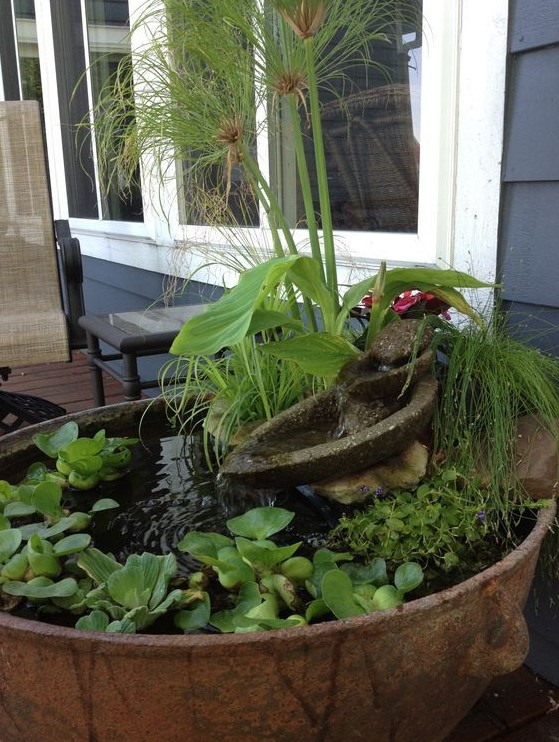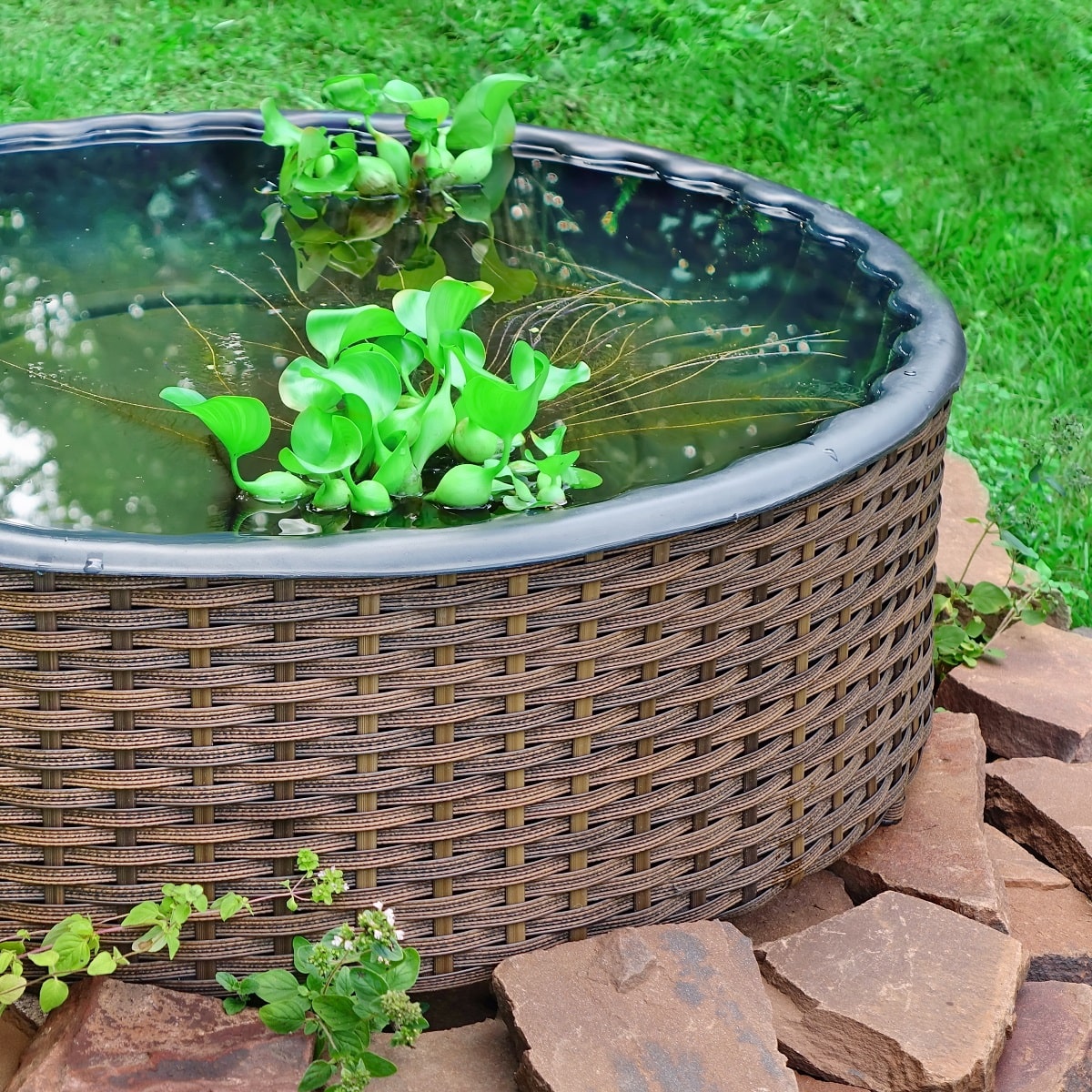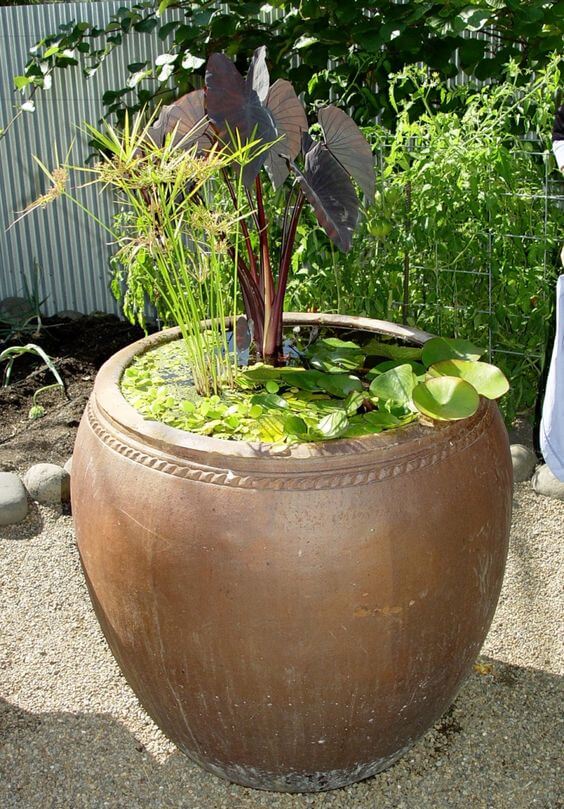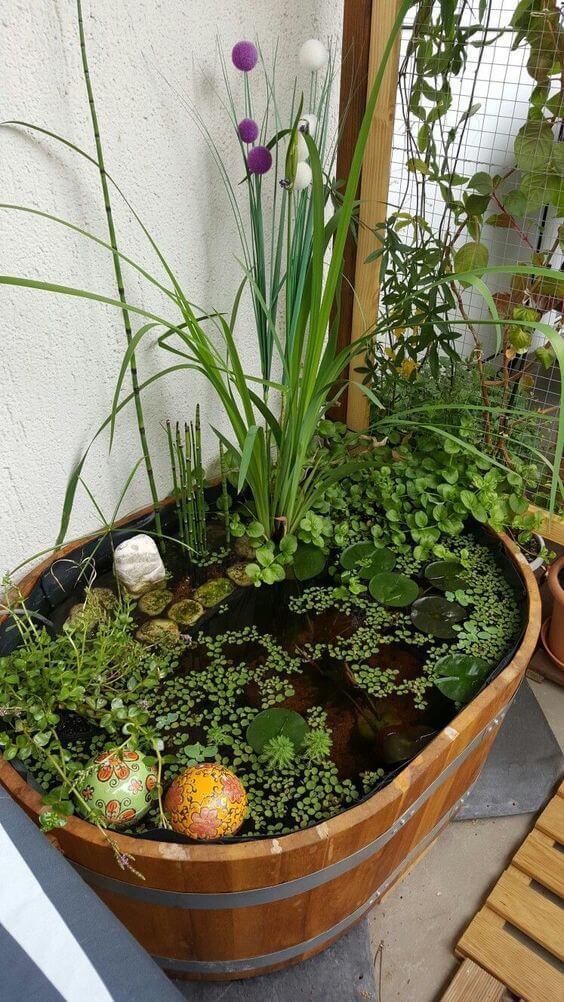Tiny Ponds: Big Container Garden Wow!
Tiny Ponds: Big Container Garden Wow!
Creating a tranquil oasis in even the smallest of spaces is entirely achievable with the magic of container water gardens. Forget sprawling, land-hungry ponds; the beauty of aquatic life and the calming sounds of trickling water can be yours, regardless of garden size or even the absence of a garden altogether. This guide delves into the art of crafting stunning tiny ponds in containers, exploring design, plant selection, maintenance, and the sheer joy of bringing this miniature ecosystem to life.

The Allure of Miniature Water Gardens
The appeal of a container water garden extends far beyond its aesthetic charm. These self-contained ecosystems offer a unique opportunity to connect with nature, fostering a sense of peace and tranquility in a busy world. The gentle sounds of water, the vibrant colors of aquatic plants, and the mesmerizing movement of fish (if included) create a captivating focal point that transforms any space. Moreover, they're incredibly versatile:
- Space-Saving Solutions: Perfect for balconies, patios, rooftops, and even indoor spaces with sufficient sunlight.
- Design Flexibility: Choose from a vast array of containers, from terracotta pots to repurposed barrels, reflecting your personal style and the overall aesthetic of your environment.
- Easy Maintenance: Compared to larger ponds, container water gardens require less upkeep, making them ideal for busy individuals.
- Creative Expression: Unleash your inner artist by experimenting with different plant combinations, container styles, and decorative elements.

Choosing the Right Container
The success of your tiny pond hinges significantly on selecting the appropriate container. Consider these crucial factors:
- Size and Shape: While "tiny" is the keyword, ensure your container is large enough to support the plants and any aquatic life you intend to incorporate. A minimum depth of 12 inches is recommended for most aquatic plants. The shape is a matter of personal preference, but consider how the shape will affect the visual appeal and the ease of access for maintenance.
- Material: Durable, waterproof materials are essential. Terracotta pots are classic and aesthetically pleasing, but they're prone to cracking if they freeze. Plastic containers are more durable and affordable, while fiberglass offers excellent longevity and resistance to cracking. Repurposed containers such as old sinks, tubs, or even large buckets can add a unique touch. Just ensure they are thoroughly cleaned and free of harmful chemicals.
- Drainage: Surprisingly, drainage is crucial, even for a water garden. While the container will hold water, good drainage prevents waterlogging and potential root rot. If your chosen container lacks pre-existing drainage holes, you can drill some carefully. Consider lining the base with a layer of gravel to improve drainage.

Essential Components of Your Tiny Pond
Once you've selected your container, it's time to assemble the core elements:
- Substrate: A layer of gravel forms the base, providing drainage and a stable foundation for your plants. Avoid using sand, which can compact and restrict water flow. Top this with a layer of aquarium soil or a specialized pond substrate, ensuring it's suitable for aquatic plants.
- Plants: This is where the real magic happens! Choose oxygenating plants like hornwort or anacharis to maintain water quality. Then, select attractive flowering plants and foliage plants based on the size and depth of your container. Some popular choices include:
- Water Lilies (dwarf varieties): These iconic aquatic plants add beauty and shade.
- Water Hyacinth: These floating plants add texture and color.
- Pickerelweed: Known for its striking blue flowers.
- Arrowhead: Offers attractive foliage and is relatively easy to care for.
- Water: Use tap water that has been allowed to sit for at least 24 hours to allow chlorine to dissipate. Avoid using distilled water, as it lacks essential minerals.

Adding Aquatic Life (Optional)
Introducing aquatic life to your tiny pond adds another dimension of beauty and interest. However, responsible ownership is critical. Consider:
- Fish: Choose small, hardy fish species suitable for the size of your container. Goldfish, for example, can be suitable for larger containers, but they require ample space. Overstocking can quickly lead to water quality issues.
- Snails: Snails can help control algae, but monitor their population to prevent overgrowth.

Maintaining Your Tiny Pond Paradise
While container water gardens require less upkeep than larger ponds, regular maintenance is still essential:
- Water Changes: Partially change the water every 2-4 weeks, removing about 25-50% of the water and replacing it with fresh, dechlorinated water.
- Algae Control: Monitor for algae growth. Excessive algae can indicate an imbalance in the ecosystem. Regular water changes, proper plant selection, and avoiding overfeeding fish (if present) can help control algae.
- Plant Trimming: Regularly trim overgrown plants to prevent them from overwhelming the container and impacting water flow.
- Winter Care: In colder climates, consider bringing your container indoors during winter to protect plants and any aquatic life.

Creative Design Ideas for Tiny Ponds
The beauty of container water gardens lies in their adaptability. Here are some creative ideas to inspire your design:
- Layered Landscaping: Create depth and visual interest by layering plants of varying heights and textures.
- Container Selection: Experiment with different container materials and shapes to achieve unique aesthetics. Repurposed containers, such as vintage sinks or metal buckets, add a rustic charm.
- Decorative Elements: Add decorative stones, pebbles, or small figurines to complement the aquatic plants and enhance the overall visual appeal.
- Integration with Existing Landscapes: Seamlessly integrate your tiny pond into your existing garden design, using pathways, stepping stones, or other landscape elements to create a cohesive look.
- Lighting: Adding strategically placed lighting can transform your tiny pond into a mesmerizing nighttime spectacle.

Troubleshooting Common Problems
- Cloudy Water: This often indicates an excess of nutrients or decaying organic matter. Water changes and improving filtration can help.
- Algae Blooms: This can stem from excessive sunlight, nutrient overload, or insufficient oxygenating plants. Address the underlying cause and consider adding more oxygenating plants.
- Plant Die-Off: This may be due to inadequate sunlight, improper planting depth, or nutrient deficiencies. Adjust your approach accordingly.
The Joy of Tiny Ponds


Creating a tiny pond in a container is a rewarding experience that connects you with the beauty and tranquility of nature. It's a testament to the fact that grand experiences can arise from small beginnings. The process of planning, planting, and maintaining your miniature ecosystem offers a unique opportunity for creative expression, relaxation, and a profound appreciation for the wonders of the natural world. So, embrace the challenge, and let your container water garden become a source of joy and inspiration in your life. The "wow" factor is guaranteed!
Tiny Ponds, Big Impact: Container Water Gardens
For those with limited space or a desire for low-maintenance beauty, container water gardens offer a delightful alternative to traditional ponds. These miniature aquatic ecosystems, housed in various containers from simple terracotta pots to elaborate troughs, bring the tranquility and charm of a water feature to even the smallest of gardens, patios, or balconies. This comprehensive guide explores the planning, creation, and maintenance of these enchanting miniature worlds, helping you harness their big impact despite their tiny size.
Planning Your Container Water Garden: Size, Style, and Site Selection
The first step in creating your container water garden is meticulous planning. This ensures success and avoids common pitfalls associated with miniature aquatic environments.
Choosing the Right Container:
The choice of container significantly impacts the success of your water garden. Consider these factors:
-
Size and Shape: The size dictates the scale of your garden. Larger containers offer more planting options and stability. The shape influences the aesthetic appeal; rectangular troughs provide a structured look, while rounded pots offer a more natural feel. Depth is crucial; at least 12 inches is recommended to accommodate aquatic plants with deeper root systems.
-
Material: Durable, non-toxic materials are paramount. Plastic containers are affordable and lightweight but can degrade over time in direct sunlight. Fiberglass is more durable and UV-resistant. Terracotta pots offer a rustic charm but are porous, leading to increased evaporation and potential algae issues. Concrete or stone containers provide a lasting and aesthetically pleasing option but are significantly heavier.
-
Drainage: While you need water retention, proper drainage is crucial to prevent root rot. Ensure the container has drainage holes (unless specifically designed for water features) and consider using a layer of gravel at the base for drainage and aeration. Avoid containers with cracks or significant imperfections that could leak.
Choosing the Perfect Location:
The location of your container water garden impacts its health and longevity. Consider the following:
-
Sunlight: Most aquatic plants thrive in at least 6 hours of sunlight per day. However, excessive sun can lead to rapid algae growth and overheating. A location with partial shade during the hottest part of the day is ideal.
-
Accessibility: Choose a location that allows for easy access for maintenance tasks like water changes, plant trimming, and cleaning.
-
Stability: Ensure the container is placed on a stable, level surface to prevent tipping or shifting, especially if using heavier containers. Consider adding weight to the base if necessary.
-
Aesthetic considerations: Where will the container look best in your overall garden design? Consider the surrounding plants and structures.
Designing Your Miniature Ecosystem: Plants, Substrate, and Water Features
The artistic heart of your container water garden lies in its design. Careful selection of plants, substrate, and any additional water features will create a visually stunning and thriving miniature ecosystem.
Choosing Aquatic Plants:
The selection of plants is crucial for a balanced and visually appealing water garden. Choose a mix of:
-
Oxygenating Plants: These plants, such as Elodea and Hornwort, are vital for maintaining water quality by releasing oxygen and absorbing nutrients. They are generally submerged and relatively low-maintenance.
-
Marginal Plants: These plants grow at the edges of the water, their roots submerged and their leaves reaching above the water's surface. Examples include Irises, Canna lilies, and Water Forget-Me-Nots. They add color and texture.
-
Floating Plants: These plants, such as Water Lettuce and Duckweed, float on the water's surface, providing shade and helping to prevent algae growth. However, they can spread rapidly, so careful monitoring is essential.
-
Submerged Plants: These plants live completely underwater, contributing to oxygenation and water clarity. They include plants like Vallisneria and various types of Anacharis.
When choosing plants, consider their mature size and growth rate to avoid overcrowding. Research individual plant needs regarding sunlight and water conditions.
Creating the Substrate:
The substrate is the base layer of your container water garden. It provides anchoring for plants and helps maintain water clarity. Common substrate options include:
-
Gravel: Provides drainage and aeration. Choose smooth, non-sharp gravel.
-
Pond Soil: Specifically formulated for aquatic plants, it provides essential nutrients.
- Lava Rock: Porous and aesthetically pleasing, it provides a habitat for beneficial bacteria.
Create layers; typically, a drainage layer (gravel), followed by pond soil, and then topped with a decorative layer of gravel or pebbles.
Adding Water Features (Optional):

Adding small water features can enhance the aesthetic appeal and create a more dynamic environment. Consider:
-
Small Fountains or Pumps: These add movement and aeration to the water, helping to prevent stagnation and algae growth.
-
Rocks and Pebbles: Create visual interest and provide habitats for beneficial microorganisms.

- Miniature Waterfalls: If your container is large enough, a small waterfall can add a charming focal point.
Maintaining Your Container Water Garden: A Guide to Long-Term Health
Maintaining your container water garden requires consistent attention, but the effort is well rewarded with a thriving and beautiful miniature ecosystem.

Water Changes:
Regular water changes are essential to prevent nutrient buildup and algae blooms. Aim for partial water changes (approximately 25-50%) every 2-4 weeks, depending on the size of your container and the climate. Use dechlorinated water.
Algae Control:

Algae can quickly become a problem in small water gardens. Effective control strategies include:
-
Regular cleaning: Remove any visible algae from the container walls and plants.
-
Balanced planting: Ensure a good balance of oxygenating and other aquatic plants.

-
Partial shading: Avoid excessive sunlight.
-
Water changes: Regular water changes help dilute nutrient levels that fuel algae growth.
-
Beneficial Bacteria: Adding beneficial bacteria can help improve water clarity.

Plant Maintenance:
Regularly trim and remove dead or decaying plant material to maintain water quality and prevent disease. Thin out plants if they become overcrowded.
Winter Care:

In colder climates, protect your container water garden during winter. Move the container to a sheltered location, such as a garage or unheated porch, to prevent freezing. If possible, keep the water from completely freezing.
Troubleshooting Common Problems:
- Cloudy water: Indicates nutrient buildup or decaying plant matter. Perform water changes and remove dead plant material.
- Algae blooms: Address excessive sunlight, nutrient levels, and plant balance.
- Plant die-off: Check for root rot, nutrient deficiencies, or pest infestations.

Expanding Your Container Water Garden: Creative Ideas and Inspiration
Once you've mastered the basics, you can expand your container water garden creativity with these ideas:
- Multiple Containers: Create a collection of smaller water gardens to create a more expansive aquatic display.
- Integrated Designs: Incorporate your container water garden into other garden features, such as a raised bed or patio.
- Themed Gardens: Create a themed water garden, such as a Japanese-inspired Zen garden or a tropical paradise.
- Experiment with Different Plants: Try diverse plant species and combinations to create unique visual effects.
- Incorporate Art and Accessories: Add decorative elements such as small sculptures, driftwood, or colorful rocks.

By following these guidelines and embracing your creativity, you can transform a small space into a captivating haven of beauty and tranquility with a container water garden. These miniature aquatic ecosystems are not only visually stunning but also provide a rewarding and educational experience, allowing you to connect with nature in a deeply personal way. The effort invested in planning, creating, and maintaining these tiny ponds is well worth the big impact they have on your outdoor space.


